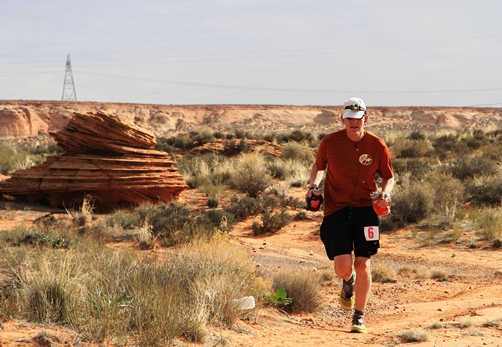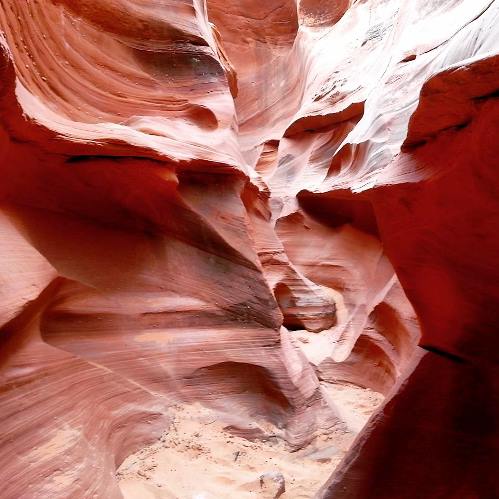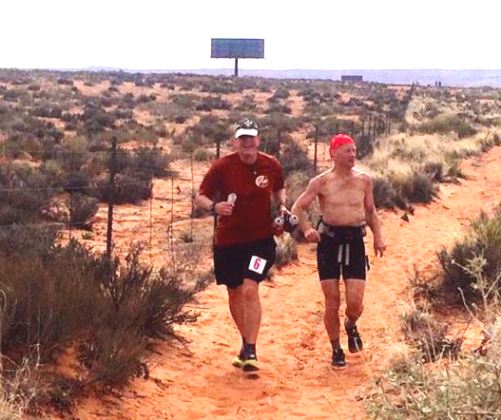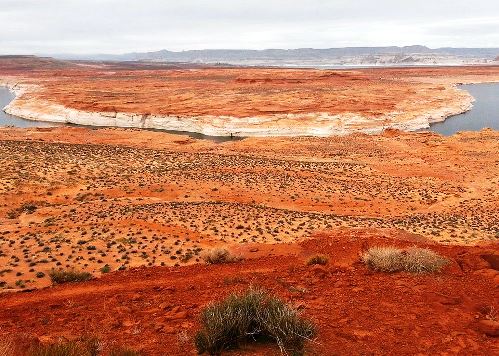Antelope Canyon 100 is run in and around the spectacular and unusual city of Page, Arizona. Page was founded in 1957 as a housing community for those building Glen Canyon Dam across the Colorado River. The city is perched on top of Manson Mesa above beautiful Lake Powell. If you like running through slot canyons, on slickrock next to cliffs, across miles of open desert, this one is probably for you. The name for the race, Antelope Canyon, comes from a famous slot canyon that we would run through, normally only accessed by private tour companies permitted by the Navajo Nation.
This was the first year for the 100-mile distance at this race and a handful of daring runners including myself decided to sign up. Concurrently with this race are also distances of 50-miles, 55K, and 25K. With some quick research on the race, I quickly knew that the most important word about this race was a four-letter word: SAND. I knew that I must prepare myself for the sand and even sought out sandy areas near my home to practice and mentally prepare. The race director, Matt Gunn, estimated that the 50-mile and 100-mile runners would be running through about 30-miles of sand.
I arrived the day before the race to prepare and rest. I was hoping for my 66th 100-mile finish and third for the year already. I previewed sections of the course and did some good practice running in the deep sand, selecting the shoes that seemed to perform the best. The pre-race dinner, Navajo tacos, was amazing. I enjoyed meeting other runners and talking about what our experience would be during the coming day. Some 50-milers scoffed somewhat about the 100-mile course which would end up with six 10.6 mile loops around the city of page on the rim of Manson Mesa. I tried to explain that this would be a great 100-mile course. After killing myself with miles of sand during the first 40 miles, I looked forward to the idea of more controlled loops on a groomed, rolling mountain bike trail around the edge of the rim. Too many runners think loops are stupid and boring. Most have never tried it. Believe me, it never became boring, nor was it easy.
At 6:00 a.m. on the next morning, we gathered at the start under an amazing amphitheater of rocks. Our first obstacle was a fun short climb up and over a mesa. Our lights could be seen for miles bouncing up and down. I’m sure we created quite a stir among the people driving below, wondering what was happening. A pretty big group of speedy runners separated from the rest of the pack and I watched them start to disappear ahead. With my chronic sore leg, I now have to start slowly until warmed up. I hung with the second group but soon I was all alone between groups. It was very peaceful as dawn was approaching.
We first would be faced with a long sandy 13.5-mile journey out to Antelope Canyon and back. By mile 2, we were on a lengthy, very sandy, straight power-line road heading in the direction of a massive power plant (Salt River Project) with lights blazing in the distance, and cars heading toward it for work. I concentrated on my sand running technique and managed to keep up a steady 10:00 pace.
At about mile four, a runner caught up to me and asked where the front-runners were. He was convinced that I was running in first place. I explained that there was a large group far ahead, out of sight. With that distraction, I soon realized why they were out of sight. I missed a turn. Thankfully I heard yells from behind and we got back on course, only doing an extra tenth of a mile or so. My new friend seemed upset to see runners now ahead of him. I wouldn’t see him again until mile 23 when he was lost in the desert and out of water because he didn’t carry any.
We entered our first of three slot canyons. Still pretty dark, it was amazing to run through, dodging back and forth, making sharp turns and trying not to bang my head on overhanging rocks.

After exiting the slot I came into the Antelope Aid Station at mile 5. We then became introduced to a very wide sandy wash travelled by the tour company vehicles to get to Antelope Canyon. Did I mention sand? Wow! For the next three miles I truly learned how to run on sand, continually trying to pick the tracks that were the firmest and fastest. I didn’t really notice, but we were also climbing about 150 feet during those three miles and that made it extra tough. My buddy Carter Williams caught up and greeted me as we both worked hard on our sand running.

Finally I arrived at the entrance of Upper Antelope Canyon. I entered this famed canyon with a feeling of respect for the Navajos, some who treated the canyon like a cathedral. There was now full morning light, but in the deep slot canyon it was still pretty dark. The shadows were amazing to see and I shifted back and forth around the walls. Running fast was impossible and also seemed wrong, missing the amazing sights. Unfortunately the slot finally ended much faster than expected and I was back out on the desert wash.
After more sand wash slogging, we climbed out of the canyon and ran on a sandy trial along the rim. Down below, Kendall Wimmer saw me and yelled up. I returned the greeting and in another few miles he caught up. We ran through yet another small slot canyon and then returned to the main three-mile wash where the runners in the back were still making their way to Antelope Canyon. It was amazing how much easier it was to do the sand running with a very slight decline. I was even able to crank off a 9:18 mile in the sand. I returned to the Antelope Canyon station (mile 10.7) at 1:56.

The next section returning back to the powerline road was rather confusing. I think we should have dropped back down into the slot canyon we first went through, but those around me all missed it and followed footsteps in the sand ahead of us. After a while, I looked back and noticed runners on a wrong, different road confused, about the cut the course significantly. I motioned that they needed to go clear down to a turnaround point, but I fear many runners cut off about a half mile of the course. I stopped worrying about it, put my head down and pushed on.
The morning weather was ideal out in the open desert with no trees in sight. There was a nice cloud cover for most of the day so the temperature was ideal for running. I ran at a comfortable pace, not really concentrating on racing, it was more about surviving through the sand. When I reached the Slickrock Aid station (mile 16.8) at 3:13 it was time to empty out the shoes. I marveled that some runners didn’t use gaitors and I saw them often emptying out shoes, but even with the gaitors I needed to stop every 15 miles or so the clean things out.

Next up was more wide-open desert running, but with views of the outskirts of Page. A lead, very speedy front-runner in the 55K came toward me heading toward his finish and I later greeted several friends doing well in their race. After a fast fence-line straight sandy run I reached the Horseshoe Bend aid station (mile 19.8) at 3:52. I was in good spirits, feeling well as several friends greeted me.

The next section is described as “an area that few humans have traveled.” This was my favorite section of the course. This wasn’t a trail, it is just a marked route across rough slickrock. The Colorado River does a sharp bend called Horseshoe Bend. The route took us out there and for a couple miles hugged the rim and cliffs below closely. It is very technical, hard to run fast, but truly is enjoyable after so many miles of sand. There was so much to see, my pace slowed to a 14-minute mile. Matt Van Horn was out there with his drone and took video of me as I ran through a section. That crazy machine was buzzing all around me for about five minutes.

The route next crossed over a slickrock filled desert section to visit another bend in the river. As I made better time, I concentrated on following footsteps in the sand and soon detected that there were no trail markers around me. Two other guys were stopped, confused. We obviously had been following the footsteps of many other runners who had gone off course. We spread out and I headed further west and eventually found flags again, waved to the others and went on. We were told this section was supposed to be eight miles between aid stations, but it turned out to be only 6.6 miles. The route is impossible to duplicate each year, so it must have been short-changed.

I arrived at Waterholes Aid station (mile 26.5) at about 5:45. Yes, that is a pretty slow marathon, but I wasn’t concerned. We next dropped down into the amazing Waterhole slot canyon. Wow! With much better light, I was even more impressed by this slot than the previous ones. It reminded me of many slots I have explored in Capitol Reef National Park and Buckskin Gulch. It lasted for a mile, our last slot canyon for the day.

We climbed out and were faced with another long straight power-line road back to the Horseshoe Bend aid station. The sand wasn’t as deep on this road and I was able to open up the speed, clocking some sub-10:00 speed which at this point felt very fast. I arrived back at Horseshoe Bend (mile 31.2) at 6:34, a slow but tough 50K.
The run back to Page on trails already run, was pretty uneventful. Scattered with me were 50-milers, 55Kers, and 25Kers. All seemed happy and enjoying the day. I made the climb up to Page Rim and arrived at this major aid station (mile 36.2) at about 8:15. I made a long stop to clean the feet, retape, and visit the bathroom.

All prepared, I was now ready to face six loops on the Page Rim trail high up on the edge of Manson Mesa. This trail was fast and forgiving after so many miles of sand. There was no sand here, just a rolling mountain bike trail. I loved running the loop before dark, being able to see all the sights along the way. Including an out-and-back to an aid station about half way, the loop was about 10.6 miles, longer than advertised but it made up for distance missed earlier in the race. However, I estimate that the 50-mile course was grossly short, no more than 47.5 miles, if truly measured, probably under 47 miles. Yes, the GPS lost signal for short sections during the slots, but the distance lost was minor.

The first half of the loop was fast, a loss of 300 feet, and the return side came into the urban area below homes and through a golf course with lots up short climbs. I now was feeling rather tired and slow, not eating enough, but ran the loop in about 2.5 hours. I felt the best on my second loop. The sun set halfway through and the lights shining from various places made it and entire different experience. In no way was it boring. The wildlife appeared and in this case they were rabbits along the golf course. They would be seen all night running ahead across my path. I ran the second loop in 2:25. But my stops were getting long. I was at mile 57.5 after the second loop at the 14:00 mark, 8:00 p.m. The third loop took me about three hours and was rough. My stomach went south, the fun departed and I started to have serious thoughts about quitting. But as I arrived at the next station stop, by then I was feeling a bit better and continued on. I went into this race with a bad cough and it was getting worse, affecting my breathing, but I tried not to think of that as an excuse to quit.
My story turns sad from here. At 11:15 p.m., after my third loop, at mile 68.2, I could be found in a cot, at the Page Rim aid station. I stopped for about a half hour, trying to rest and recover, attempting to salvage my race. I still had more than 40 miles to go and I questioned if I really had it inside me today. But I pushed on for loop #4.
During the 4th loop, all of the slow 50-milers were finally off the course and it was very lonely with just a handful of 100-milers scattered across the 10-mile loop. Something was new for this loop – the wind! A cold headwind blew against us during the first three miles of the loop that really sapped the strength. I leap-frogged with a lady runner with her pacer who was a full loop behind me. I wondered how it was possible for her to finish by 30 hours, but she kept pushing on. I became very drowsy and stopped in a ditch, out of the wind, and took just a five-minute cat nap. That was amazing help and after that it felt like I was sprinting, but my pace never went faster than 12:00 pace on that loop. I was able to catch back up to the runners ahead, even with my stop. I would then run far ahead and at times would never see any runner lights for a very long time.
When I reached the Lake Powell aid station, I was in very bad shape. It was 12:50 a.m., mile 72.6, and again I had to lie down in a cot. I groaned and moaned as I tried everything to get my stomach working so I could truly run fast again. My slow pace was discouraging. The young lady tending the aid station was concerned, but I assured her that this was very normal and let her know that I had finished 65 100s. After a 20-minute stop, I was on my way again, feeling much better, catching runners who had passed me during my rest.
I had again planned to quit after loop 4, but when I arrived, I felt great at nearly 79 miles. I could do this, just two more loops with nine hours to go — so I thought. The wind increased as the edge of a big cold front was making its way in. Rain started to sprinkle but wasn’t much of a bother. The last forecast I had read called for 20% chance of rain but I had planned to finish before dawn. I looked to the north and west and the clouds looked very dark. When I arrived at the Lake Powell aid station, I wisely asked if they had a garbage bag for me to use as a poncho. They did, but it was very flimsy, better than nothing. I stuffed it in my pocket and pushed on. I was keeping ahead of everyone behind me, but the pace was painfully slow, 17-19-minute miles. I wasn’t having fun anymore, just going into survival mode. One section above Lake Powell was very exposed and looked very scary, especially in the dark. The trail went right along a steep cliff edge and as I shined my light down, there was no bottom to be seen in the dark. It really bothered my tired mind and my unstable running at that time.
At mile 86.6, at about 5:00 a.m. or so, it started to pour rain. I stopped, put on the makeshift poncho and continued on, walking. All motivation left me, my mind was mush, and I again fell victim to the DNS monster that hit me twice last year. I even started to talk to the “bunnies” along the golf course. All rational thinking went away, filling my mind with worries and lost focus. With about a mile to go in the loop, the trail was filling with water and getting very slippery in spots. I started to think about that scary cliff edge and falling off it during the next loop. The temperature was dropping. My friend Carter Williams caught up, lapping me. I was at mile 89 and he was finishing up. I told him that I was quitting, that I wasn’t going to face another loop in the rain. He didn’t have time to stop, was focused on finishing before 25 hours and pressed on.
I arrived at Page Rim aid station at about 6:30 a.m., about mile 90, with 5.5 hours to go and I firmly decided to quit. What? That seems pretty irrational and it was. At the station, the few people there were trying to get out of the cold wind, they didn’t need to try to convince me to go on, they were suffering too. I went to my drop bag and discovered that although under a tarp, it was in a big puddle of water. All my spare clothes were drenched and I had no rain gear. My makeshift poncho was it tatters. I watched a runner go on for their last loop and I started to have second thoughts about quitting. Should I continue on? I asked the aid station guy if the rain might stop, looking for any words of encouragement. He said, no way, it would get worse. So, I quit at mile 90, feeling good about it. I’ve finished so many 100-milers, and 150-milers, that the finish now lacks a level of accomplishment when my mind is mush. I do this for fun, and I wasn’t having fun so I quit.
I went on 0.6 miles to my car at the finish, and recall thinking how well my legs felt and that I now felt just fine. But my tired brain was indeed mush. I didn’t even think about the other clothes I had in my car, and that surely I could have found garbage bags at the finish area to continue on. I wanted to stop.
As I drove west for home, at about 8:00 a.m. a terrible snow storm hit. I realized that if I had continued running, that I also would have been in snow. That was more good rationalization.
Twenty four hours later after a good night’s rest, with hardly any sore muscles I started to kick myself hard. How stupid was that? I was 11.3 miles from the finish, no more than four hours away, and I quit. I had invested all the hard work to not reach the end goal. Friends had tried to find me during the night on the course. I wish they would have. All I needed was a swift kick in the butt and a couple garbage bags.
So, this was yet another disturbing 100-mile DNF for this old guy. Three out of my last five attempts have been DNFs, Cascade Crest, Bear, and now Antelope Canyon. I recall how I once had a streak of more than 30 100-mile finishes without a DNF. Now at age 56 it is getting a lot tougher to go the entire distance and it seems to be mostly mental. That is a downside for not using pacers and crew. You must find the way to do it all yourself. I’ll get this figured out and will again attempt 100 miles in just another three weeks. I can’t wait, and I’ll be extra determined. You just have to get back on the horse.
To sum up the Antelope Canyon 100. It is now one of my favorites because of its uniqueness. The sand makes it tough and slow, but was nowhere as bad as I had envisioned. The loops at night are a mental exercise but on a very enjoyable trail. Put this one on your race list, you won’t be disappointed.
I did perform one interesting experiment. A friend at work asked me to wear one of those fitbits that count your steps. They help very casual runners/walkers to find motivation to do some miles every day. It was interesting to see what 91 miles of racing looked like. I traveled about 174,000 steps during the race and blew away and fitbit leader boards I was on. It also tracked well the times I was not moving at all. I’ll probably continue to use it.





Davy unfortunately I can relate to your ‘mind mush’. After a while it is too easy to quit when its not being fun any longer. It is even worse when you can quit near a ride out.
The good sign is the DNF bothered you. When it no longer bothers you at all its time to find a new activity.
matt
Hi Davy.
Thank you for the race report. I am wondering if you ever returned to run Antelope Canyon 100 again. I have ran along side you for Squaw Peak 50, as you were doing it twice back to back. I know you have grit and determination.
I DNF’ed Cascade Crest 100, Bear 100, and just signed up for Antelope Canyon 100. Looking for some motivation and encouragement to find the finish line.
Thanks,
Callie